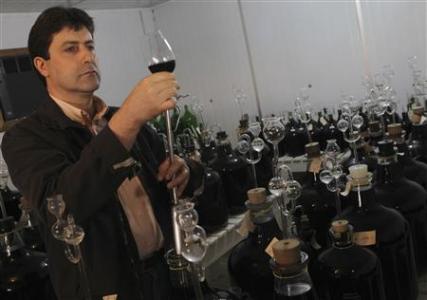(Reuters) – Brazil is widely celebrated for having some of the world’s best beaches, soccer, and Carnival festivities.

Wines? Um, no.
Nevertheless, Brazil is considering steps to protect its tiny domestic wine industry from an onslaught of imports, in what may be the most bizarre – and controversial – example to date of rising trade protectionism in South America.
President Dilma Rousseff’s government recently agreed to evaluate an emergency request from Brazilian wine producers that, if approved, could raise tariffs on many imported wines from countries including Chile, France and Spain. A final decision is expected by August, officials say.
The temporary protection measure, known in trade parlance as a “safeguard,” has been hailed by some winery owners as their only possible salvation. They argue that Brazil’s overvalued currency, high taxes and other soaring costs have left them unable to compete with imports.
Elsewhere, though, the request has sparked a backlash.
Brazil’s trading partners, already irritated by its recent protectionist moves in other sectors including the auto industry, are expressing outrage. And in big Brazilian cities such as Sao Paulo, some restaurants have removed domestic wines from their menus to protest what they see as overreach by a politically connected industry with an inferior product.
In the heart of Brazil’s wine country – a relatively chilly region of yellowish hills in the far south that bears a passing resemblance to Tuscany – the issue is just as divisive. Some producers fear the request for protection has already backfired by turning consumers against their product and straining relationships with business partners abroad.
“It’s so stupid,” said Luis Henrique Zanini, who owns a small winery. “We end up looking like we want to take away people’s freedom to choose what they want. For wine lovers, especially, that’s a sin.”
Zanini and others say the industry’s woes are merely a reflection of the bottlenecks and distortions that plague Brazil’s economy. For example: Because of the country’s notoriously high taxes, many Brazilian wines are actually cheaper to buy in Miami than in Sao Paulo.
Imports are pricier still. Even without the safeguard, a middling California Zinfandel that retails for $8 in San Francisco can cost $35 in Sao Paulo, due to a complex web of tariffs that has nurtured local industries but also made Brazil the most closed major economy in the Western Hemisphere.
Such idiosyncrasies help explain why Brazil, after a decade-long economic boom, now finds itself mired in an unexpectedly deep slump.
A lack of trade links has left the economy reliant on domestic demand – which looks fatigued – to lift it from a period of stagnant growth now in its fourth straight quarter. Rousseff is under pressure to move beyond piecemeal solutions, such as protectionism, and enact more dramatic reforms that could make Brazilian industries competitive again.
“We should be pushing for a huge tax cut, not a safeguard,” Zanini said. “And (the cut) shouldn’t be for just wine – it should be for everybody. We’re all suffering here.”
VINEYARDS IN THE TROPICS
Those pushing for protection say it’s necessary to take a long-term view – without which, they say, a wine industry might never have taken root in a tropical country in the first place.
Farmers in the “Valley of Wines,” many descended from Italian immigrants, have produced low-end table wines for a century. Yet the mass production of so-called fine wines – made from globally recognizable grape varieties such as merlot and chardonnay – didn’t really begin until the 1990s.
Despite their short history, and challenges such as a humid climate that gives many Brazilian wines a strong acidic taste, some vintages have won accolades.
In 2011, Brazilian wines received more than 100 medals in international competitions, according to Ibravin, an industry group. A Brazilian wine also won a coveted gold medal for the first time last year at the International Wine Challenge in London, which bills itself as the world’s largest wine contest.
“Brazilian wines are only beginning to develop, and we think our success so far shows we still have a lot of potential to grow,” said Adriano Miolo, chief executive officer of Brazil’s largest producer of fine wines, Miolo, which exports to several countries including China, Britain and the Netherlands.
Brazil’s fine wine industry remains relatively tiny, with annual sales of about 20 million liters. By comparison, Chile’s leading producer – Vina Concha y Toro SA – sold more than 10 times as much wine in 2011.
The industry’s ambitions are big, though. More than 30 million people have moved out of poverty and into the middle class in the past decade, and many Brazilians have developed a taste for high-end wines. Local producers reacted by increasing their output by 55 percent from 2005 to 2011.
That, however, was when things started to go awry.
Given a choice, Brazilian consumers have overwhelmingly opted for wines from Europe and elsewhere in South America. Sales of imports nearly doubled from 2005 to 2011, while sales of Brazilian fine wines shrank by 11 percent.
That led to the current crisis, in which Brazil’s fine wine sector sells about a third of what it produces.
“We can only sustain this kind of situation for another few years,” Miolo said. “Without action, Brazil’s fine wine industry could disappear.”
The crisis led the industry to ask Rousseff for special protection last year. According to the World Trade Organization, member countries are allowed to take “safeguard” action to temporarily protect a sector from imports that cause “serious injury to the industry.”
Rousseff has several options. Officials told Reuters the most likely would be a quota based on the average of imports during the previous three years. That could reduce imports by 10 percent compared with 2011 levels. Brazil imposed a similar scheme in a recent trade dispute over auto imports from Mexico.
Advocates are unapologetic, saying Europe and the United States use a variety of tools such as import duties and sanitary regulations to protect their wine industries.
“Maybe we’re being very daring,” said Carlos Paviani, Ibravin’s president. “But this is a true emergency.”
“PEOPLE THINK WE’RE IDIOTS”
The debate is so intense in the Valley of Wines that some neighbors have stopped talking to each other. And no subject is quite as thorny as the question of exactly why Brazilian wines are suffering.
Paviani, Miolo and others blame “prejudice” – what they describe as an outdated knee-jerk resistance to their products by consumers. Miolo said that, in blind taste tests, Brazilian wines frequently beat out imports – even those from France.
“This is an old problem with Brazil, this worship of things that come from Europe,” said Helio Luiz Marchioro, head of a wine cooperative. “The Brazilian consumer is tremendously uninformed.”
“You go to a restaurant in Sao Paulo, and they have 100 wines on the menu, but only three of them are domestic,” Marchioro said. “Come on – could it really be that of the 100 best wines in the world, only three are Brazilian?”
Some industry advocates aren’t quite that enthusiastic. But there is general agreement that the fine wine sector has been hurt by factors beyond its control – such as Brazil’s currency, which despite recent losses is still about 40 percent stronger than in 2005, making imports much cheaper.
Deep-pocketed European governments also sponsor regular tastings in Sao Paulo and Rio de Janeiro, something Brazilian wineries can afford to do only once a year, producers said.
Miolo and other producers said the safeguard will give the wine industry a “window of opportunity” to invest and market their products on a more level playing field.
They also vow to improve the wine itself and have enlisted the help of Brazil’s agricultural research agency, Embrapa. The agency earned global renown for developing soybean varieties that can grow in arid climates, a breakthrough that underpinned Brazil’s recent farm boom. At a lab in the city of Bento Goncalves, scientists conduct experiments with beakers of wine from nearby farms, hoping to improve the grapes.
“I know there are people who think we’re a bunch of idiots, but we have a plan and it’s going to work if we get this safeguard,” said Jose Fernando da Silva Protas, a senior Embrapa official.
Rousseff has deep roots in the state of Rio Grande do Sul, home to the Valley of Wines, where she spent the formative years of her political career. Officials close to the president say she sees wine as one of many Brazilian industries that have been unfairly damaged by expansionary monetary policy in Europe and the United States – which has the net effect of making imports from those countries cheaper.
As a result, Rousseff has moved to protect several sectors, including autos and kitchen appliances, by erecting new barriers to trade. At a wine festival in February she vowed to combat the deluge of foreign wines, calling embattled local producers “heroes.”
“This region is (capable) of producing the best wines in the world,” Rousseff said. “We’re not going to sit still … we’re going to combat predatory trade practices.”
DIABOLICALLY HIGH TAXES
Critics say Rousseff seems to be ignoring a simple, but fundamental, question: What if Brazilian wines as a whole just aren’t very good?
Many of the international accolades have been awarded to Brazil’s sparkling wines, a narrow segment that does well under local conditions. Other wines, particularly reds, have not shown as much ability to compete.
“The problem is that the government’s treating wine like it’s a commodity, like sugar or corn,” said Daniel Geisse, whose winery has won several awards abroad. “But wine is about so much more – you’re buying the terroir, the production, the history, the philosophy.
“That’s why the reaction has been so negative. We’ve developed a good wine culture in Brazil over the past decade. But now these people feel like they’ve been disrespected.”
Geisse also worries that, by limiting imports, authorities risk extinguishing that incipient love affair with wine – especially in a country where consumers have plenty of options. “These people don’t realize that our biggest enemy isn’t imported wines – it’s beer.” he said. “Wine was always a tough sell here.”
Advocates of the safeguard concede they might never be able to compete at the very high end of the market. With greater protections, though, they say they can compete in a range of $12 to $25 a bottle.
Whether that’s so is unclear. Rodrigo Martins, who runs a wine bar in a tony area of Sao Paulo, said he used to carry about 50 Brazilian wines among the 500 or so in his store. They didn’t sell, and he now offers no more than five.
“We tried to do the right thing,” he said. “Our customers said many of them were expensive, and of inferior quality.”
Geisse said some Brazilian wineries may end up going bankrupt. Those with a good product would be better served by government initiatives that reduce costs for the sector and improve access to credit, he said.
One common plea – throughout Brazil – is for lower taxes. Ademir Brandelli, another small winery owner, said taxes account for 56 percent of the price of his wines. “There’s no way we can compete with our neighbors at that level, safeguard or not,” he said.
Paviani, the head of the industry association, said a decade of lobbying for lower taxes has failed to make major progress, making the safeguard necessary.
He also lamented the structural issues holding the industry back, citing high prices on everything from cork to glass.
“If it was easier to import bottles, that would make a big difference for us,” Paviani said.
But what if Brazil’s bottle makers then asked for a safeguard for themselves?
“That’s different,” he said. “Glass is the same everywhere. Wines, well, they’re an exception.”
(Additional reporting by Alice Pereira; Editing by Kieran Murray and Douglas Royalty)





